

For those of you who are only familiar with my Civ3 page, it may be a bit of a surprise to see this section. But yes, I do play other games, and I've been playing Dance Dance Revolution (DDR) for long enough now that I decided to make a fansite for it. In part, this is an introduction to the game (well, games, since there are more than 20 versions by now) for those who might not otherwise be exposed to it, and also an introduction to the tons of fun I've been having since I started playing. The less-noble purpose of this section is to serve as a repository for my high scores and to track my progress, now that I feel good enough not to be embarassed by putting my scores online. I should also point out that since the average DDR player is somewhere in the 12-17 age bracket, much of the fan-created content is somewhat, umm, lacking in insight. "i would say that i am extreamly good 4 only playing the game 4 only 7 months (at home for 5 months till my ignition pad got torn up and i can only play in the arcade every weekend). LOM: C (no bar) (o0o ya and i did that at home on my poopy pad a week after DDR 8th mix came out 4PS2)" That's an actual quote I found browsing an online forum today, by the way. If nothing else, I hope my writing is easier to understand than that!
* * * * *
What is DDR? In short, it's a dancing simulation game, in which the player must step on four different arrows (UP, DOWN, LEFT, and RIGHT) in time with music playing in the background. DDR-ing doesn't look very much like real dancing though, and the game is probably better described as a game of pattern recognition and repetition. Only - you don't input the arrows with your hands, you do it with your feet on special dance pads (you can use a controller if desired, but what fun is Controller Controller Revolution?) The most difficult songs contain extremely complex patterns of notes, or get insanely fast - or BOTH. Therefore, DDR mastery requires both quasi-mathematical pattern recognition skills and extremely fast reflexes and balance. Of course, you can also ignore everything and jump right into random arrow-mashing. That's part of the fun!
DDR is meant to be played on big arcade machines, like the one in the picture below:
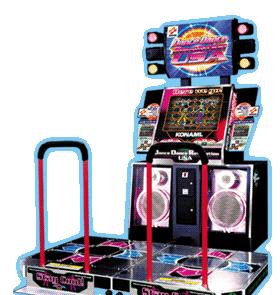
While these machines are on the whole great, there are a few problems with them. The first is simply an issue of cost; a new DDR Extreme arcade machine will cost you a cool $6000 to bring home (and yet - there are more people than you'd think who have these monstrosities at home). Even if I could afford one of these, which I can't, there is no space in my apartment for one of these 1000+ pound dance platforms. If you want to play on the actual DDR machine, therefore, it's pretty much necessary to go to an arcade, which is also a problem - since you obviously have to pay to play. Most places are 3 songs for a dollar; the closest arcade to me has a very good deal of 5 songs for a dollar. That sounds pretty good, but I estimate I've played literally thousands of songs in just the last eight months, and that would eat up a ton of money in short order. Learning to become good at DDR by solely playing in the arcades would require tons of time and money that I don't have. It's also not exactly convenient to have to go to an arcade every time you want to play a game. For me at least, the solution is therefore to play this game almost entirely at home on a console system; I have almost no experience with the arcade machine at all. Now the only reason I go to all the trouble to point this out is due to the fact that there are large numbers of individuals in the DDR community who consider any scores from the home versions of DDR to be invalid. While they are entitled to their opinions, I will be playing on my PS2 home versions and enjoying myself immensely (so there!)
The rest of this page showcases some pictures of what a typical game of DDR looks like for those who have never seen it before. DDR vets can probably skip this part, or read through with a knowing smile. Opening up a game of DDR, whether in the arcade or the home versions, brings the player first to a mode select screen:
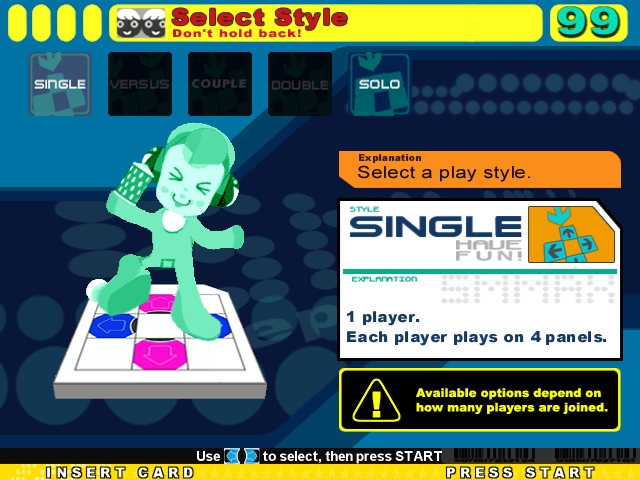
This images and the ones that follow are taken from a computer version of DDR called Stepmania, which can be downloaded free off the Internet and simulates the dancing games. As far as this picture goes, Single is the most common mode, designed for one person playing alone. Versus is the basic two-player mode, each player dancing against the other on the same song to see who can score higher. Doubles is a special one-player mode where the player uses TWO pads at once (it can get pretty crazy). The other two modes in this picture (Couple and Solo) are extremely rare and not found in most versions of DDR. Couple has two players working together on each song; this is only found in some very obscure Japanese mixes of DDR. Solo adds two diagonal arrows for a total of SIX; this mode is also almost never seen. Single, Versus, and Double are the usual modes.
After selecting one of the modes (in this case Single), the next screen asks you to select a difficulty:
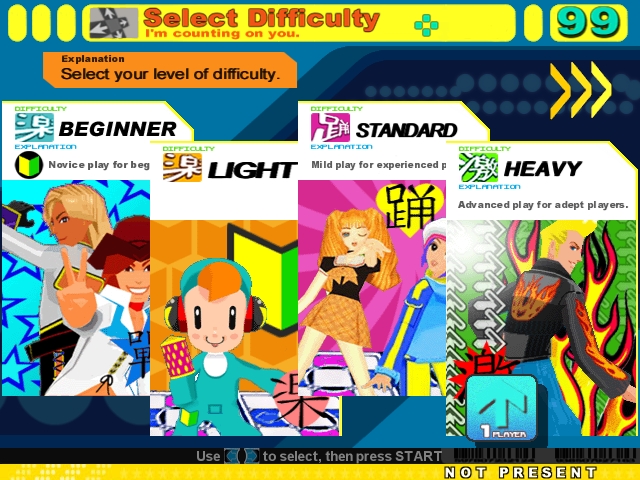
As you can see, there are 4 different difficulties that you can choose from. The first of these is Beginner, which was actually the last to be added (older DDR mixes only had the other three; Beginner was added to make the game easier to pick up and play). All of the songs on Beginner have a difficulty rating of only 1, 2, or 3 (this is out of 10; more on this in a minute). About 90% of the songs are rated as 1s on Beginner (for those with musical knowledge, the songs are entirely whole notes and half notes), so anyone should be able to jump right in. The background screen will also have an animated character on a dance pad showing you when and where to step if you select Beginner difficulty, which I think is a nice touch.
Still, it won't take most players long to graduate from Beginner up to Light difficulty. Beginner is really for people who might be playing DDR at a party or something like that; people who have actually bought the game should probably start at Light. Songs on Light are usually rated as 3s and 4s (again, out of 10) although there are a few songs that have higher or lower ratings. Songs on Light tend to stick almost entirely to the beat; don't expect much deviation or off-beat patterns (Light songs are almost without fail a constant stream of quarter notes). Light is a great place to start and learn the songs, but with time players will graduate and move up in difficulty. Light also used to be called "Basic" in the earlier DDR mixes before Konami went to the easier-to-understand current system.
Standard difficulty is the "in the middle" level which seems to get the least play (most players are either learning on Light or experienced and do Heavy). Songs on Standard generally have a difficulty of 5 or 6, although there are a fair number of 7s as well. Standard is the first difficulty that starts to mix in large numbers of eighth notes (two notes in one beat of music; eight total notes spaced out across a four-beat measure of music). Expect to see lots of eighth-eighth-quarter patterns in Standard songs (and if you don't know what this means, don't worry; DDR does not require any knowledge of music - although it helps). Standard used to be called "Trick" in older versions, for no apparent reason.
Heavy is just about as hard as it gets in DDR; anything goes on this difficulty and beginning players should prepare to be humbled. There are almost no songs rated lower than a 7; most songs are 7s and 8s, but there are also significant numbers of 9s as well (and - of course - the handful of 10s are lurking here too). Eighth notes are everywhere, and unlike the short runs of notes on Standard, some of the ones on Heavy go on and on and on. One particularly difficult song called Healing Vision: Angelic Mix ends with 128 straight eight notes in a row with no break! Step patterns frequently have lots of chaos and do not stay on the beat. Playing Heavy songs is also a physical workout; after a half-dozen songs, players are usually drenched in sweat (it's a good cardio workout though!) It takes time and practice to reach this level, but it's worth it in the end because these songs are also by far the most fun tp play. Heavy used to be called "Maniac", should you hear that word.
Other modes which are not quite difficulties (they are made up of Light/Standard/Heavy songs) include Non-Stop, Oni, and Endless Modes. On the screen above, you would reach these by going to the right to another screen past Heavy. Non-Stop Mode consists of courses of songs played in sequence; as soon as one ends, you go immediately to the next. After all the songs are finished (if you pass them), you get a grade for the entire course rather than for each song. Some of the Non-Stop courses are fun, but this mode is generally the same as the main game. Oni Mode (also called Challenging Mode) is special; the player again plays a course of Light/Standard/Heavy songs, but gets a "lifebar" with 4 ticks on it. Every time he or she misses a step, one of those bars is taken away (1-3 bars refill when a song is completed). Since a typical song on Heavy has 200+ steps, this is by far the most difficult mode of all. Only true experts need apply! Oni means "devil" or "demon" in Japanese, by the way (quite accurate!) Endless Mode lets you play songs endlessly until you fail out. Pretty simple, but also fun at times.
After picking a difficulty, in this case Heavy, the player is taken to the song select screen. This definitely requires a picture for explanation:
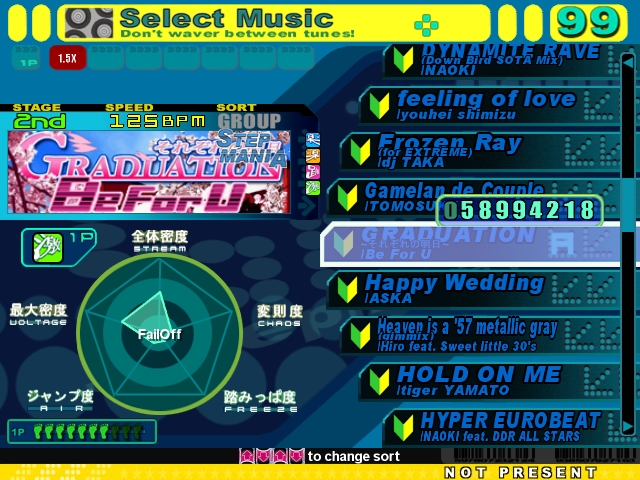
This screen diplays a lot of information, so let's go through some of it quickly. On the right is the actual song wheel itself; by pressing left and right on the pad, you can scroll through the different songs. The text for each song tells you the title (at top) and the artist in small text at the bottom. The song wheel also reveals your best grade for each song (an "A" in this case, more on scoring in a minute) and your best score for that individual song when you hover over it. To the left, there is a graphic for each song again announcing the title and artist in larger detail. In this example, the song is "Graduation" and the musical artist is the Japanese pop group BeForU. A 10-second clip from the song also plays while you hover over it, although you obviously can't tell this from the photo.
Above the large graphic is more information. The Stage tells you which song you are on (2nd in this case), which doesn't really matter at home but means a lot when you're paying for each song in an arcade! The Speed is also provided in Beats Per Minute (bpm), a term that I'll use a lot on this site. Bpm is a real musical term that literally does what it says, gives you the number of beats (musical pulses) for each minute. 125bpm, as in this example, would be a touch faster than 2 beats each second (which would be 120bpm). 125bpm is not that fast; try counting two beats for each second to get an idea of the speed. Most songs fall in the range of 120-150bpm, but there are some very slow songs (less than 100) and also some very fast ones (going over 200bpm and even 300bpm). Almost all of the most difficult songs are extremely fast, although one is actually difficult for being extremely slow! Finally, the Sort info tells you how the songs are arranged; "Group" is the default arrangement, but you can also go alphabetically, by speed, or by "most played."
You're probably wondering what the weird pentagon thingie in the bottom left corner is all about. DDR calls this the "Groove Radar" (don't laugh), and it's designed to give you an idea of what a song will contain without actually playing it. Divided into five parts, the radar tells you how hard the song will be in each category (further out towards the edge means more difficult). Stream refers to the speed of the song and the overall number of notes; fast songs with long runs will have a high Stream. Voltage refers to the density of notes in the song; if a bunch of notes are crammed together in a very small part of the song, it will have high Voltage. Stream and Voltage usually tend to go together, but sometimes there will be a slow song with one tough section (low Stream, high Voltage) or a fast song which stays simple throughout (high Stream, low Voltage). Air is a measure of how many "double" steps there are in a song; that is, steps which require the player to hit two notes at once (Left + Right and Up + Down are the most common). Freeze is a measure of how many freeze notes (a step that must be held down for a certain length of time) are in the song. Finally, Chaos measures, well, how much chaos there is in a song (steps not following the beat and doing some crazy pattern instead). The songs with high Chaos are brutal and show be avoided if the player has no familiarity with them. Also note the little feet at the bottom; this is where songs are ranked overal from 1-10. Thus, a song with a rating of 7 is called a "7-footer" in popular parlance. I personally like the little feet and find them amusing.
All these screens are nice, but they are basically setup information. Once you actually pick a song, you reach a different screen where the real action takes place:

This is taken from an easy song ("Cutie Chaser" isn't that intimidating, is it?) on Light. One of the nice things about DDR is that the dancing screen remains relatively simple and uncluttered. The green squiggly line at the top is your health bar (it is actually constantly pulsing and changing color while playing). If you combo steps together, it will increase and fill up to the top. Similarly, as you miss steps, it will go down and turn red; go too low and you will fail out of the song. The Stage is also listed at the top. At the bottom is the difficulty and your score (which is constantly going up as you play). Sandwiched between them is the main screen; this is where the arrows fly at you, from bottom to top. Your goal is to hit the indicated arrow when it lines up with the (unmoving) gray arrow outlines at the top. Sounds simple enough, right? Well, it is - for a song on Light like this one. It gets harder though. Here's an example:

Yikes! OK, that's not really fair; this song ("bag") is a super-slow 10-footer specifically designed to be almost impossible to read. Even on Heavy, the songs aren't really this bad. When you hit arrows, you will get a rating for each one depending on how close to the beat you stepped. The best rating is "Perfect" (although in some newer versions there is an even better rating called "Marvelous"), followed in descending order by "Great", "Good", "Boo" (called "Almost" in US versions), and "Miss" (called "Boo" in US versions, and YES this causes unnecessary confusion). A "Perfect" step is worth 2 Dance Points (2 DP), increases your health bar at the top of the screen, and starts/continues a combo. A "Great" step is worth 1 DP, increases your health bar (but not as much), and also starts/continues a combo. A "Good" step is worth 0 DP (not too good!), does not increase or decrease your life bar, and ends any ongoing combo. A "Boo" step counts as -4 DP, decreases your life bar, and also ends any combo. The dreaded "Miss" step penalizes you 8 DP, decreases your life bar a lot, and naturally ends your combo. There are also Freeze steps, notes that must be held with one foot on them for a certain amount of time. A completed Freeze gives you a message of "OK" and is worth 6 DP; a Freeze that was not held gives you the message "NG" (no good) and is worth 0 DP. All these Dance Points are not displayed anywhere on the screen, but they are important to know because they determine your grade when you finish.
When the song is over, assuming you passed you will be taken to the results screen:
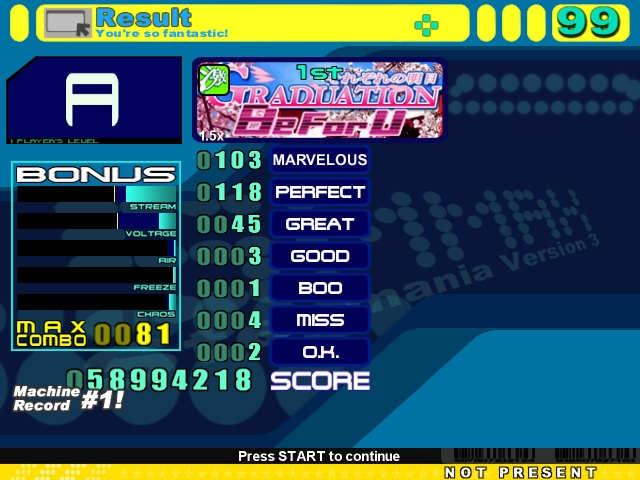
This screen shows you how you did overall for the past song. Notice that I totally suck at playing a song with the keyboard; this is not a very hard song and I barely got an "A". Also note that this computer version of DDR has the new "Marvelous" rating turned on (none of my console versions use it). Obviously the top left corner shows your overall grade; grades rank from "E" (the lowest, given for failing a song), up through "D", "C", "B", "A", "AA", and the best possible rank of "AAA". In order to figure out your grade, first figure out your score in Dance Points using the system I listed in the preceding section. (Perfect = +2, Great = +1, Good = 0, Boo = -4, Miss = -8, OK = 6). Then figure out the max score for the song; this is done by adding up all the steps for the songs and multiplying by two (as if you had gotten a Perfect on each one), and then adding this to all the OKs times six. Then divide YOUR score by the MAX score. You will then get a percentage which determines your grade. Take a look at the example below:
Taking Marvelouses as Perfects, we have 221 Perfect/45 Great/3 Good/1 Boo/4 Miss/2 OK.
Our score: 221*2 + 45 + 3*0 - 1*4 - 4*8 + 2*6 = 463
Max Score: (221 + 45 + 3 + 1 + 4)*2 + 2*6 = 560
Percentage: 463/560 = 82.7%
We would therefore have a score of 82.7% for this case (again, this is not a good effort from me but it made a good example). All grades are determined by these percentages. An "E" is a failing grade, easy enough to understand; a "D" is a passed song with a percentage under 45% ("D"s are actually quite rare, since if you have under 45% on a song, you usually fail!) "C" falls in the 45-65% range, "B" between 65-80%, "A" 80-93%, "AA" 93-99.9%, and the elusive "AAA" is literally a perfect score, only awarded for a 100% run on a song (all Perfects and all freezes held). This scoring system is what gives DDR unbelievable replay value; a song that was a challenge to "A" can always be returned to later to try and get a "AA", and even easy songs remain a challenge to "AAA". As in bowling, a perfect score IS possible, but so difficult that you can spend a virtual lifetime trying to achieve it. It's the thrill of always knowing I can do better that keeps me coming back to this game over and over again.
Note: All of the above information is based on the modern scoring system for DDR. Some of the older mixes have strange ways of calculating grades and scores. For more information on this, and the complex formula that calculates the score points (the 58,994,218 number), please see AaronInJapan's excellent DDR page. Also be aware that the newest version of DDR (SuperNOVA) uses a slightly different scoring system, but overall it's virtually identical.
Once you've finished your first song, you'll be taken back to the song select screen for the next one. And with that step, this walkthrough of some of the basics of DDR is concluded. The next page discusses how I first learned about the DDR series and provides what will hopefully be some helpful advice and tips for anyone thinking about trying this entertaining game.



